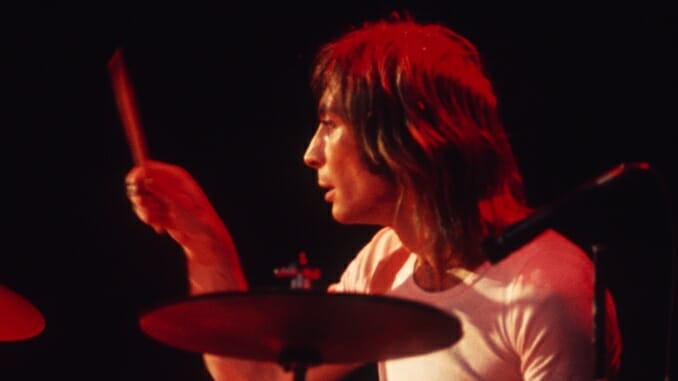The Curmudgeon: There’s No Rolling Stones Without Charlie Watts
Photo by Joe Sia/Wolfgangs
One could forgive the Rolling Stones for carrying on after the death of Brian Jones in 1969 and Bill Wyman’s retirement in 1993. They were important contributors to the legendary band but not essential. You could easily argue that Darryl Jones was as good a bassist as Wyman, and that Mick Taylor and then Ronnie Wood were improvements on Jones.
It will be harder to forgive The Stones for carrying on after the death of Charlie Watts on Tuesday at age 80. As Bruce Springsteen once wrote, “As much as Mick’s voice and Keith’s guitar, Charlie Watts’s snare sound is The Rolling Stones.” If you dig for the secret of the band’s chemistry, it’s the rhythmic tension between Keith Richards and Watts. Mick Jagger’s vocals are just the icing on the cake.
Listen to “Start Me Up,” a song so infectious that it’s still used to kick off many athletic events. It begins with one of Richards’ greatest guitar riffs: three suspended chords, a long pause and then the same cluster of three, repeated three times with descending pitch. The riff doesn’t really grab hold, though, till Watts taps the hi-hat and slams the snare just a hair behind Richards’ timing. And it’s that slight delay that keeps the listener spellbound. You’re already hooked before the singer opens his mouth.
Usually the listener doesn’t even know what’s happening, but one’s body wants the guitar and the snare to properly align or to clearly separate. They never do, however, so the body keeps waiting, keeps yearning for it to happen. It seems as if the song is always on the verge of clicking into place or completely falling apart, but it never does. And it’s that constant possibility of resolution or disintegration that makes the band’s best songs so thrilling.
Most of us think of a beat as a single point in time, but musicians as attuned as Richards and Watts hear a beat as a short span of time with a beginning, middle and end. With the guitar on the front end and the snare on the back end, they create musical drama that’s irresistible. It’s difficult to create and even harder to ignore.
Watts could pull this off, because he was a 21-year-old jazz drummer before he joined The Rolling Stones on February 2, 1963, 58 years ago. He knew how to swing by displacing the accent just off the beat. He knew how to adjust to a bandleader who would make up things as he went along—whether it was Lester Young acolyte Dick Heckstall-Smith in Watts’ old band, Alexis Korner’s Blues Incorporated, or Keith Richards in his new band.
At first The Stones relied heavily on remaking American R&B hits by Chuck Berry, Bobby Womack, Solomon Burke and the like. As much as they tried to copy the originals, they couldn’t help injecting themselves into the music and creating something brand new. Not only the push-and-pull between Richards and Watts, but also the boyish sneer of Jagger’s vocals made the songs sound younger, jazzier, more British. And when Jagger and Richards started writing songs such as “Heart of Stone” and “Congratulations,” they sounded more original still.
The band burst out of the London nightclub scene and rode The Beatles’ coattails to America. When The Beatles imploded in 1970, The Rolling Stones were left as the biggest rock ‘n’ roll band in the world. And they deserved the title, for the snare-and-guitar tension between Richards and Watts was never better than when a well-crafted Jagger-Richards composition was on top of it. And from 1965’s The Rolling Stones Now to 1981’s Tattoo You, such compositions filled every album with the perfect vehicles for the Richards-Watts tandem.
After 1981, the songwriting magic dried up, and The Stones became a repertory band, replaying their classic songs as the latter-day Count Basie Band or Frank Sinatra might. But it was still worthwhile to file into the local basketball arena to see The Stones one more time, for there was always a good chance that the Richards-and-Watts sparks might ignite one more time.
When I saw them at Washington’s football stadium in 1994, for example, the show began with Watts playing an unaccompanied solo built around the Bo Diddley beat. He had the vast crowd clapping along—always a bit ahead of him—before the rest of the band even took the stage. This led into Buddy Holly’s “Not Fade Away,” the first song on the band’s first U.S. album.
It was Watts again who lit a fire under the third song, “Tumbling Dice.” With Richards’ memorable intro still hanging in the air, the drummer knocked it into focus with his first snare hit. His subsequent crisp swing pattern allowed Richards to fill his guitar chords with intoxicating anticipations, drones and suspensions. Relative rarities such as “You Got Me Rocking,” “Memory Motel,” “Monkey Man” and The Temptations’ “I Can’t Get Next to You” kept the musicians interested in the show between the old hits.
-

-

-

-

-

-

-

-

-

-

-

-

-

-

-

-

-

-

-

-

-

-

-

-

-

-

-

-

-

-

-

-

-

-

-

-

-

-

-

-








































